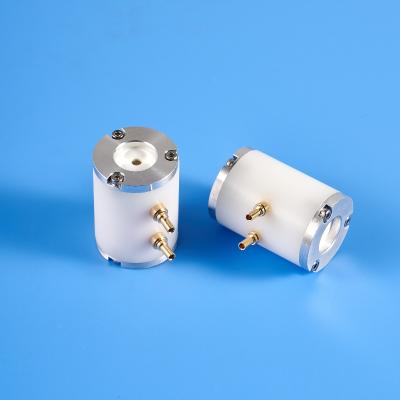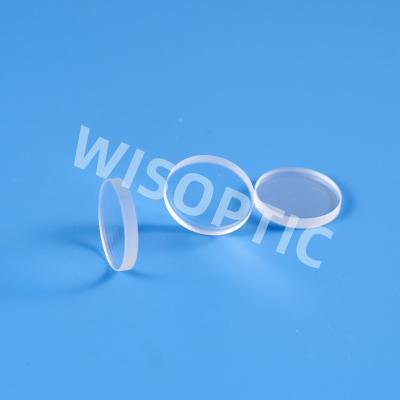Lithium Tantalate Crystal and Its Application - 12
3 The main application of lithium tantalate crystal
3.4 Pyroelectric detector
To detect targets, pyroelectric detectors generally exchange heat with the outside environment through three methods: thermal convection, thermal conduction and thermal radiation. The working principle is: electrons are adsorbed on the surface of the pyroelectric material, and the surface is neutral; the temperature of the material surface changes when heated, and the electric dipole moment of the material changes; in order to keep the surface of the material neutral, the surface releases charges. Pyroelectric sensors generally have the advantages of high detection rate, wide operating frequency, low cost, simple structure and fast response speed.
Pyroelectric detector detection units include ceramics, single crystals, and thin films. Ceramics mainly use potassium tantalate niobate and lead zirconate titanate. Single crystal materials generally use lithium niobate and lithium tantalate. Commonly used films include lithium tantalate film and lead zirconate titanate film. Lithium tantalate crystal is widely used in pyroelectric detectors because of its good pyroelectric coefficient, Curie point and dielectric constant. Dong Hangrong and others conducted research on terahertz pyroelectric detectors and designed a terahertz pyroelectric detector with a photosensitive diameter of φ10mm. The terahertz pyroelectric detector model was designed through finite element analysis and thermoelectric coupling simulation analysis. By optimizing the thinning polishing and stripping process, the development of the terahertz pyroelectric detector was completed. After testing, the detector has a responsivity of 371.8 V/W, good response time, high integration, and low noise power, which effectively solves the problem of large spot terahertz beam power testing. Zhao Ling et al. prepared ultra-thin LiTaO3 wafers by pre-setting 20 μm deep grooves on the surface of the wafer. The carbon black infrared absorption layer was prepared using the electrospray method. Analysis of the carbon black infrared absorption layer showed that when the electrospray time was 20 min, the carbon black particles had evenly covered the entire substrate surface, and the infrared absorption rate of the absorption layer reached 98%, the blackbody detection rate of the detector reaches 1.78×108cm·Hz1/2/W. Anonymous et al. designed a pyroelectric lithium tantalate detector using a 7 μm thick chip, which is suitable for Fourier transform infrared spectroscopy. The detector does not require additional cooling by the Peltier element at high temperatures and provides a typical specific detection rate of 4.0×109 at 10 Hz.
Cheng Jinbao analyzed and optimized the process parameters of the wafer thinning and polishing, and used high-voltage electrostatic spraying to prepare the ink-carbon black infrared absorption layer. Finally, the sensitive components that were thinned, polished and prepared with the absorption layer were packaged into devices. After testing, the thinner the lithium tantalate wafer, the better the response rate. The response of the device is proportional to the power of the incident light. At high frequencies, the voltage response of the device gradually decreases with its frequency. The equivalent noise power of the detector is 4.3×10-10W/Hz1/2, and the specific detection rate is 3.3×108cm·Hz1/2/W, good performance, meeting the requirements of pyroelectric detectors. Wang Jianfei combined the current research status of room temperature detectors and designed an infrared detection sensor based on lithium tantalate film by optimizing the sensitive single structure, absorption layer and preparation process to achieve room temperature detection. Under room temperature conditions, when the pulse frequency is 3Hz, the minimum equivalent noise power of the device is 7.46×10-4W/Hz1/2, and the detection rate reaches 1.34×103Hz1/2/W. The absorption of the selected absorption layer reaches 94%, meeting the detection needs. Zhou Libing and others prepared a dual-channel infrared pyroelectric detector based on a lithium tantalate wafer. The optical gas chamber used a combination of two ellipsoids and a spherical top surface, which not only improved the coupling efficiency of light propagation, but also be beneficial to the miniaturization of sensor modules. In addition, a temperature and humidity compensation algorithm based on the least squares method is proposed to achieve a measurement accuracy of ±0.9%. Zhang Kaisheng et al. designed a wavelength-selective absorption detector in which thermoelectric materials are integrated with metamaterial perfect absorbers (MPA). LiTaO3 single crystal with metal films on both sides was selected as the substrate, and a metal-dielectric metal-type MPA was deposited on top of it. The MPA structure consists of a SiO2 dielectric layer and a cross-type periodic unit, providing high selective absorption at 3.16 μm. Thermoelectric voltagei s generated as the incident radiant power is converted into heat by the dielectric layer and diffuses into the lithium.



